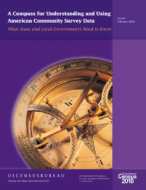What State and Local Governments Need to Know
What State and Local Governments Need to Know
A primary mission of state and local governments is to deliver efficient services and enact policies that advance public safety and economic growth. For decades, data from the decennial census long form have provided invaluable information that helped frame these issues in the proper context, enabling governments to create proposals, develop budgets, and execute strategies to address well-documented needs. With the elimination of the long form, state and local governments must avail themselves of the U.S. Census Bureau’s American Community Survey (ACS), which will now provide detailed information about the population and housing attributes of states, counties, and municipalities, large and small. In addition, the ACS will offer state and local governments a more dynamic picture oftheir communities.
Unlike the decennial censuses, the ACS is a continuous national survey. Rather than collect data as of a single decennial reference point, the ACS collects data nearly every day and summarizes it over 1-, 3-, and 5-year periods. Much like the census, the ACS provides a picture of the social, economic, and housing characteristics of the population, but it has the added advantage of providing these data on a yearly basis. The provision of more current data is not without its tradeoffs, which include smaller samples and therefore higher levels of variability. In fact, ACS data users will be faced with compromises between the provision of current data and the reliability of estimates. The most significant of these choices will involve the use of estimates for small areas involving multiple years of data.
While differences between the decennial census and the ACS may be subtle, they frequently necessitate a new analytical approach. The major goal of this handbook is to illustrate how ACS data can be used to address typical issues faced by state and local governments and, in the process, provide information that can facilitate an effective transition to ACS data.
A glossary and a series of technical appendixes—for those interested in more advanced ACS applications— are included at the back of this handbook.
See All American Community Survey Handbooks
Others in Series
Publication
Publication
Publication




